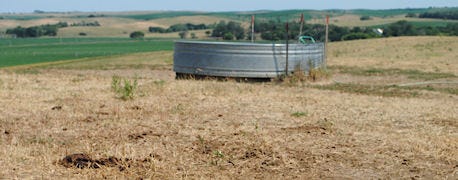August 10, 2012

Tanks that are used to haul nitrogen-based fertilizer should not be used to transport any type of drinking water supply for animals. Steve Ensley, of Iowa State University's Veterinary Diagnostic and Production Animal Medicine Department at Ames, warns that once a tank has been used to haul fertilizer, it's very difficult, if not impossible, to remove all of the nitrogen sources from that tank.

Be careful which tank you use if you're hauling water for livestock. Once a tank has been used to haul fertilizer, it's difficult if not impossible to remove all the nitrogen sources from the tank.
"Any nitrogen sources remaining in the tank can potentially cause nitrate toxicosis in ruminant animals," Ensley says. "During a drought many forages become elevated in nitrate concentration so you don't want to compound any issues with feed and water nitrate concentrations because they are additive. We strongly recommend that you haul drinking water only in tanks that are dedicated to that purpose."
The ISU Veterinary Diagnostic Laboratory offers water quality testing. For more information on that and all the tests offered, click here.
Manure control for small beef feedlots is a tour set for Northwest Iowa
Iowa State University Extension and Outreach and the Iowa Beef Center at ISU will host a three-site tour for beef producers in Lyon County early next month. Extension ag engineer Kris Kohl said the half-day tour on Aug. 7 will take place in northwest Iowa and it will provide an opportunity for feedlot operators to look at different manure control structures and management options for small open feedlots. Attendees on this tour will also have the opportunity to hear from Extension staff on costs associated and related to each system.
"Two of the locations feature effluent pumping and are part of a demonstration project funded by the Iowa Beef Center," Kohl says. "The third shows an alternative technology of a settling basin with grass infiltration strip and is funded with EQIP dollars."
* The tour starts at 1 p.m. at the Brian Mogler farm located two miles south of the town of Lester at 1695 Dove Avenue (which is county road K30). This location demonstrates how producers can collect manure effluent below settling basins and pump the effluent to nearby cropland, redirecting the nutrients away from water sources.
~~~PAGE_BREAK_HERE~~~* The second stop begins at approximately 2:15 p.m. at the Perry Mogler farm located at 2027 100th St., at Larchwood. This site demonstrates the use of a settling basin with a grass infiltration strip.
* The third stop will start at approximately 3:30 p.m. at the Gary Twedt farm located at 1652 Beech Ave., near Larchwood. The Twedt farm will demonstrate an effluent pumping system.
Offers a look at effective solutions to control pollution from small feedlots
The pumping demonstrations at the first and third sites are part of an IBC-funded project to look at the cost-effectiveness of using pumps to manage effluent from settling basins at small feedlots under the permit threshold size of 1,000 beef animals. Iowa law requires all feedlots, regardless of size, to settle the manure solids coming off a feedlot. Once the solids are settled, the effluent can be released as long as it does not cause a water quality violation. One effective solution is to use small pumps to divert the effluent runoff from drainage pathways and distribute it on crop fields where growing crops can use the water and the nutrients.
This tour is supported in part by the "Water Quality Initiatives for Small Iowa Beef and Dairy Feedlot Operations" project. Primary objectives of the project are to:
1) Educate producers to better understand the pollution potential of open feedlots
2) Train producers to accurately assess the water pollution potential of their feedlots
3) Assist producers to identify and evaluate appropriate runoff control alternatives and 4) Provide technical assistance to producers to implement solutions that improve the environmental performance of their feedlots. More information about this initiative can be found at www.agronext.iastate.edu/immag/smallfeedlotsdairy.html.
You May Also Like




